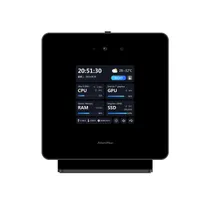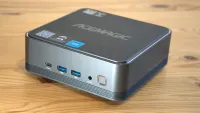TechRadar Verdict
This is a gorgeously made machine, and the Ultra 9 processor is remarkably powerful, but the difference in performance between this and an Ultra 7 machine is modest. The desirable aspects are the build quality and the OCulink port, with the inbuilt display being a less vital feature.
Pros
- +
Powerful platform
- +
ARC graphics
- +
Dual M.2 Slots and dual 5GbE LAN
- +
Aluminium case
- +
WiFi 7
Cons
- -
Internal access requires the feet removing
- -
No Thunderbolt ports
- -
Display software needs some work
Why you can trust TechRadar
30-second review
Mini PCs, or NUCs as some call them, generally fall into two categories. Many come with a metal plate designed to use the VESA holes on the back of many monitors to locate the system and turn that screen into a complete computing platform.
The alternative, as pursued by those who designed the AtomMan X7 Ti, is to make the system more accessible and desktop sitting.
While the AtomMan X7 Ti can sit on the desk, it comes with a metal bracket that holds it off the surface and presents the top with its inbuilt touch LCD for seeing system information or a digital clock. Besides the display, this design’s special feature is its Windows Hello-compliant camera, making it suitable for those who regularly conference.
The third special aspect of the AtomMan X7 Ti is the processor it uses. It is the first mini PC we’ve seen that uses the Intel Core Ultra 9 185H, one of the new Meteor Lake processors that sport sixteen cores and can process twenty-two threads simultaneously.
All this technology, along with NVMe storage and DDR5 SODIM memory, is neatly packaged in a high-quality aluminium case with vents on the top to keep it cool in use.
We've tested the best mini PCs and with this specification, features, and build quality, the AtomMan X7 Ti was never going to be inexpensive, but compared to some alternatives, it is pricey.
TechRadar exclusive: Save $20 on the AtomMan X7 Ti mini PC
Get an extra $20 off with code X7Ti-20
Choose between the barebones or 32GB/1TB configurations and save twenty dollars with the TechRadar-exclusive code: X7Ti-20
Offer available at the Minisforum website here.
AtomMan X7 Ti: Price and availability
- How much does it cost? From $669/€759
- When is it out? Available to pre-order now
- Where can you get it? Directly from Minisforum
Recently released for pre-order via the Minisforum store, the AtomMan X7 Ti is available as a barebones SKU, with no memory or storage included or with 32GB of DDR5 pre-installed and 1TB of NVMe storage.
Sign up to the TechRadar Pro newsletter to get all the top news, opinion, features and guidance your business needs to succeed!
The ‘Early Bird’ starting price on pre-order is $629 for the barebones and $849 for the 32GB+1TB model with Windows 11 Pro installed. Either SKU can be bought with the DEG1 eGPU dock, a device that extends the PCI Express but enables the external connection via an OCulink port of a video card. For an extra $50, you can add this to the barebones and 32/1TB bundles on the official Minisforum website here.
To be clear, this is a pre-order, and the hardware is intended to ship on July 10th 2024.
The intended MSRP for the ready-to-run SKU is $1,150, which could be the price once the initial shipments have been completed.
This makes the AtomMan X7 Ti one of the more expensive mini-systems, but its specifications are better than those of many laptops that are greater than $2,000.
- Value: 4 / 5

AtomMan X7 Ti: Specs
| Item | Spec |
|---|---|
| CPU: | Intel Core Ultra 9 processor 185H (16 cores, 22 Threads) |
| GPU: | Intel ARC Graphics |
| RAM: | 32GB DDR5-5600 (2800 MHz) (16GB x 2) Expandable to 96GB |
| Storage: | 1TB M.2 2280 PCIe Gen 4 |
| Expansion: | 1x M.2 2230 PCIe Gen 4 |
| Ports: | 2x USB 4.0 Type-C, 1x OCulink Port, 2x USB 3.2 Gen 2 Type-A, 1x USB 3.2 Gen 1 Type-A, 1x USB 2.0, 1x 3.5mm combo jack, SD Card slot, 2x DMIC |
| Video ports: | 1x HDMI 2.1, 1xDisplayPort 2.0, 2x USB 4.0 |
| Networking: | 2x 5GbE LAN, WiFi 7, Bluetooth 5.2 |
| OS: | Windows 11 Pro (pre-installed) |
| Base Power: | 45W-65W |
| PSU: | 19V 6.32A 120.08W |
| Dimensions: | 145 x 145 x 48.6(mm) |
AtomMan X7 Ti: Design
- Aluminium
- Support foot
- 4-inch touch screen
Before we talk about the design, it’s worth mentioning that this machine has undergone a last-minute name change. Originally called the Minisforum UH185 Ultra, the makers gave this machine its special brand, AtomMan, and the Nvidia-like moniker of X7 Ti.
I’m not sure why it’s called the X7 since the processor inside is an Ultra 9, but that’s what Minisforum decided to name it.
The archetypical NUC is based on a four-inch motherboard design, which Intel originally used, but the X7 Ti is slightly bigger than that. A classic NUC is typically around 120mm square, so the X7 Ti is closer to 145mm on each side and nearly 50mm thick.
The extra size is probably required for cooling purposes since this machine has a powerful CPU with lots of electronics, and the M.2 slots are also cooled.
In this thermal management design, air is drawn through a circular vent on the underside and then ejected on the edge where the power button is positioned. Airflow to the underside isn’t restricted because the machine comes with a foot that angles the machine up to present the top where the LCD display is mounted.
The foot and most of the case are metal, giving this mini system a high degree of engineering finish.
While you can use the PC sitting on its own rubber feet and not the foot, this does rather mess up the orientation of just about everything.
Looking at the X7 Ti head-on, the power button, which also doubles as a fingerprint reader, is at the top, along with an SD card reader. The I/O is on the left, and what would be the front on a conventional machine is on the right.
Laying it flat on a table with the power button facing the I/O ports is reversed, but the screen is upside down. This machine also has a Windows Hello-compatible camera, which in the flat configuration ends up looking at the ceiling.
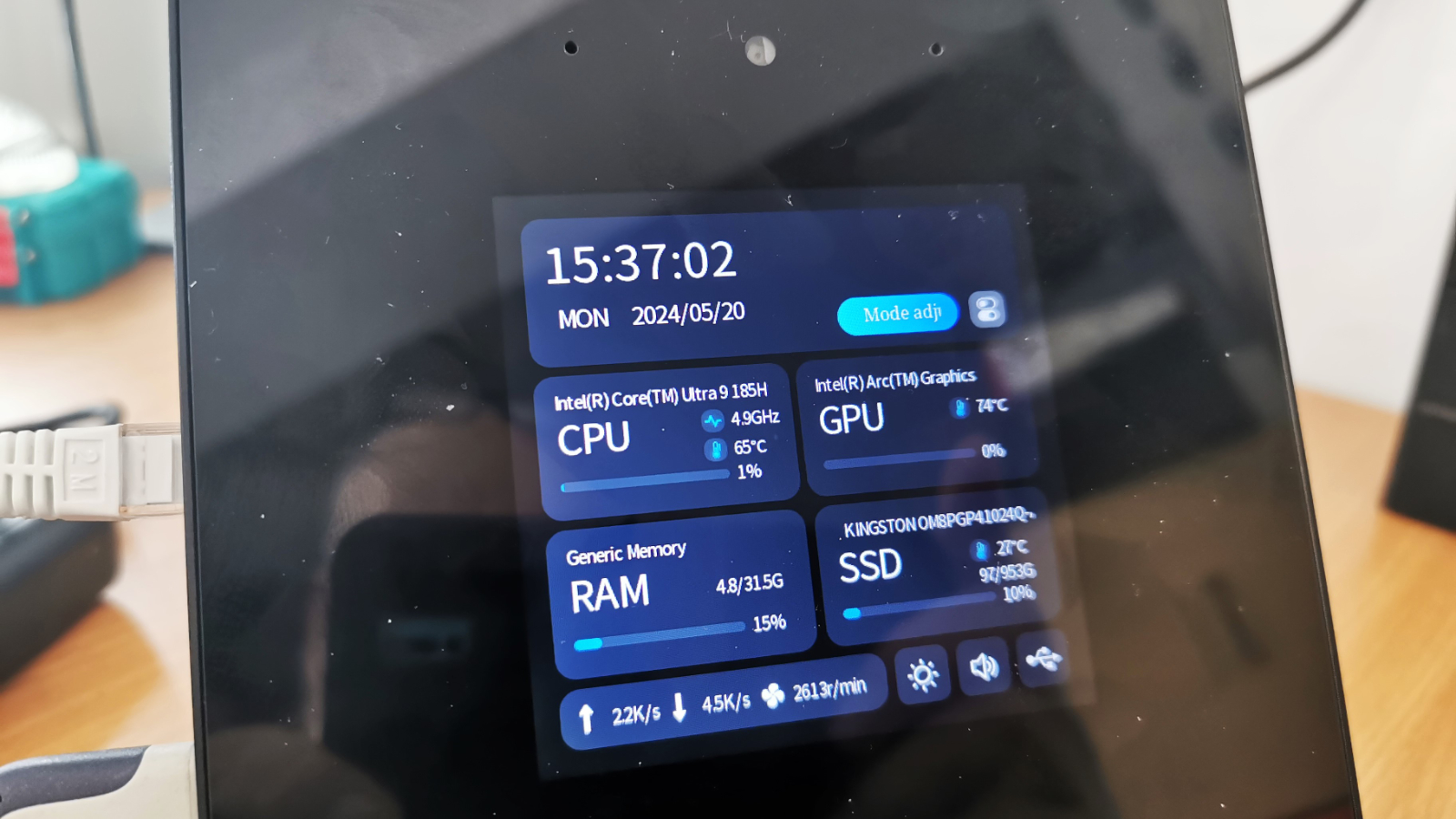
One mistake Minisforum made in a previous design was having a camera with no privacy cover. That isn’t repeated here, as a small catch on top can cover the lens. When it’s closed, a small red dot is visible where the lens is to tell you you can’t be seen.
From what we noticed, it isn’t possible to redefine the screen orientation, which makes using it without the stand something of a non-starter.
According to others, it is possible to get inside this system to add extra memory and change the NVMe drives, but that involves removing the rubber adhesive feet to gain access to the screws to open the machine. As we generally like to return without bits falling off, we didn’t open it up, and accessibility isn’t a strong point because of this.
Another complaint is the way that the machine and foot connect, which uses pegs and slots that are exceptionally loose. When trying to plug cables into the side, it is easy to knock the X7 Ti off the foot. A single retaining screw would avoid this and make the whole assembly seem like one structure.
As for the I/O provided, there are highs and lows. What this system has is plenty of USB, with two USB 4.0 and the extra special OCulink connector. What it lacks is Thunderbolt, regrettably. With makers even on higher-end mini systems going with USB 4.0 and not Thunderbolt, it looks like Intel may have overpriced Thunderbolt chips to the point where this port isn’t included.
Other than that one omission, the port selection is excellent, and the dual 5GbE LAN ports could make this an incredible system for working with server data or local processing.
This bandwidth could have been used in a single 10GbE, but the two 5GbE ports allow this machine to operate elegantly as a firewall between two network segments.
Overall, this is a beautifully made idiosyncratic design, though it needed more rationalisation before it went into production.
- Design: 4 / 5
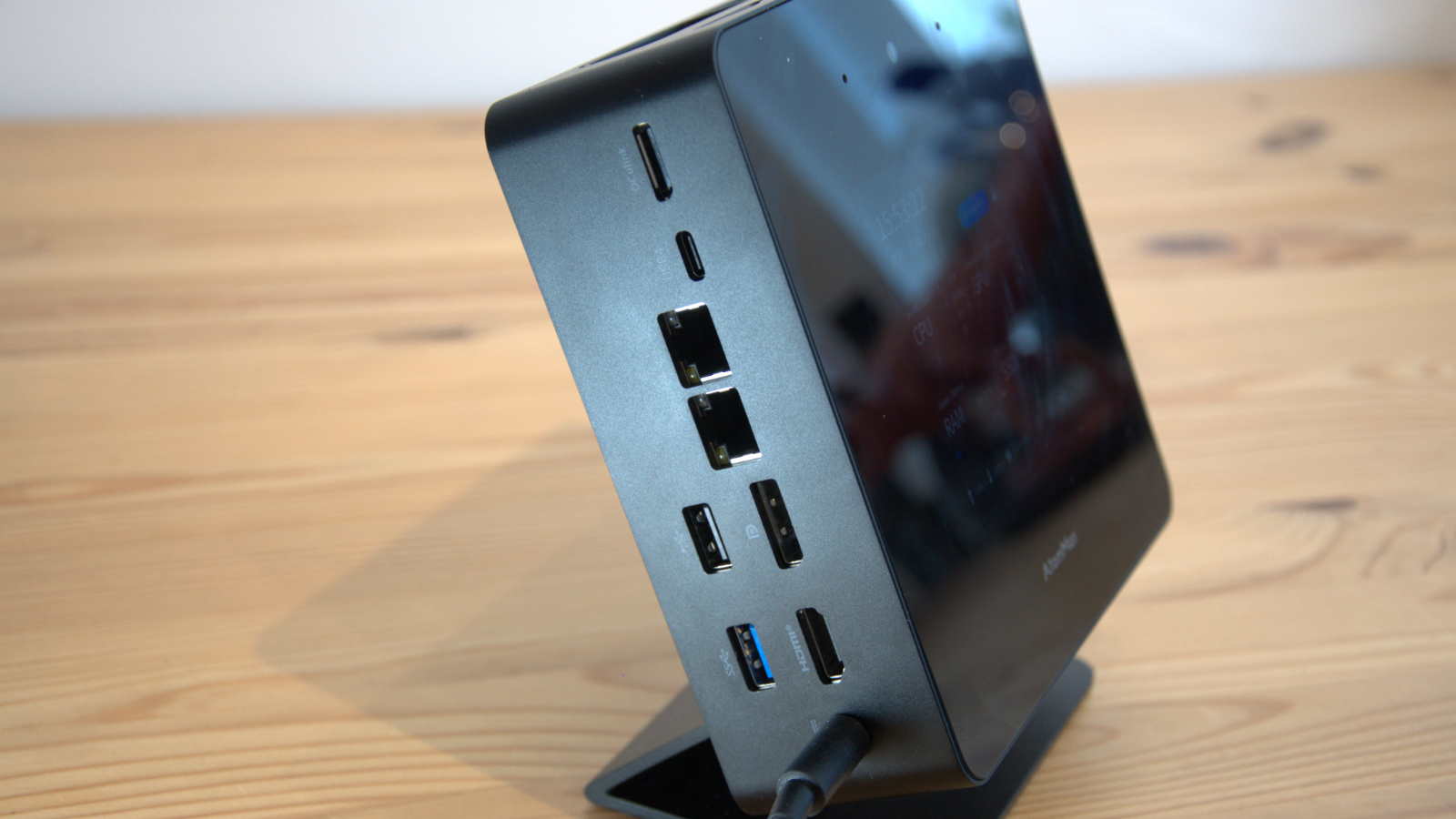
AtomMan X7 Ti: Features
- Intel Core Ultra 9 processor 185H
- 28 PCIe Lanes
- ARC Graphics
Having recently reviewed the Acemagic F2A and its Intel Core Ultra 5 125H processor, we were keen to experience the higher-end silicon in this design.
The Intel Core Ultra 9 processor 185H, to give it an overlong title, is one of the new Meteor Lake chips. Intel has decided it is in the Core Ultra processors Series 1, not the 14th generation of the Core series chips.
It’s a triple core-type design with six performance cores, eight efficiency cores and two low-power efficiency cores, a total of 16. As only the performance cores are hyperthreaded, the thread count is 22.
The top clock speed under turbo boosting is 5.1GHz on the performance cores, and 3.8GHz on the efficiency cores. The base power profile is 45W, which can be increased up to a maximum of 115W in theory, although this machine is capped at 65W, and the provided PSU only offers 120W for the system and any peripherals connected to it.
The machine is configurable to run in quiet mode using only 45-54W, balanced mode with 54W and 65W for performance. Our experience is that this machine is generally quiet, even in performance mode. These numbers can be manually adjusted in the BIOS but limited to a maximum of 65W.
Beyond having a huge number of cores, the critical features of the Ultra 9 185H are that it can address dual channel LPDDR5 or DDR5, in this case, the latter. And, with 28 PCIe lanes, organised into 1x (x8) Gen5 + 3x (x4) Gen4 + 8x (x1,x2,x4) Gen4, it has bags of bandwidth to splash on I/O.
This system has so much bandwidth available the engineers included an OCulink port on it to allow an external video card to be connected, and that’s the first time we’ve seen that.
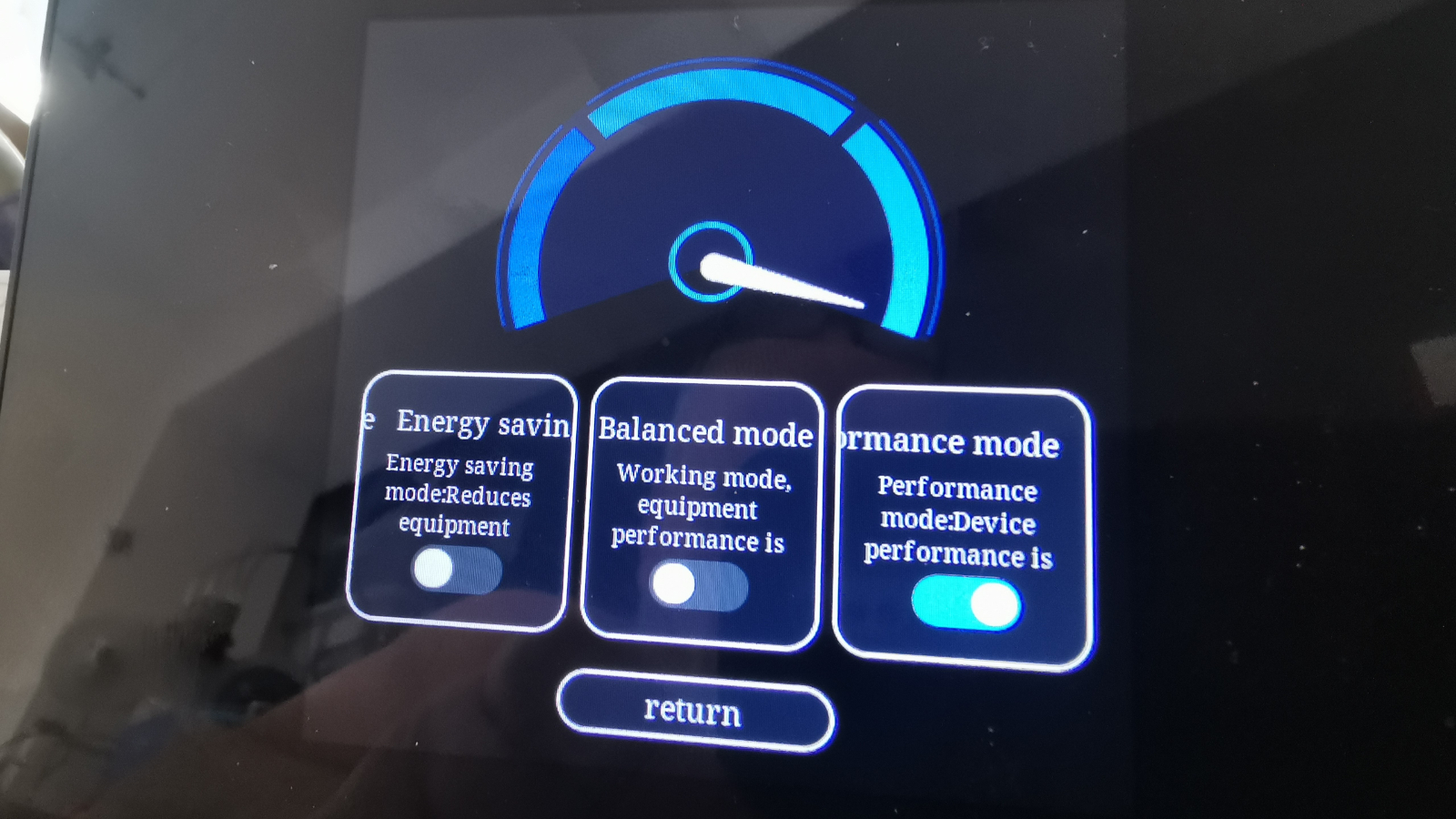
For those who don’t buy the optional DEG1 eGPU dock and the external PSU that needs to run with a graphics card, the integrated video option is Intel ARC Graphics with eight Xe-cores.
The clock speed for ARC Graphics on this processor is 2.35GHz, a bit more than the 2.3GHz seen on the Core Ultra 7 165H, but with the same eight Xe-cores.
Those who want ultimate graphics performance must consider buying the DEG1 eGPU dock and attaching a desktop GPU, like the Nvidia RTX 4090. However, unless you have that video card spare, buying that one component and a PSU to power it would dwarf the outlay on the X7 Ti.
Minisforum didn’t supply a DEG1 eGPU dock with our review machine, so this isn’t something we’ve tested. But from what we’ve heard about OCLink, it might provide a means to unlock greater graphics performance for those who need it.
That would normally be enough for hardware, but the X7 Ti is also one of the first machines with WiFi 7 onboard that, with the right wireless router, could see a 20% benefit over WiFi 6E connectivity. That said, the two 5GbE LAN ports are a better choice for those who want networking performance since they could be channel bonded to deliver around 1,000MB/s if configured with the correct network infrastructure.
- Features: 4 / 5
AtomMan X7 Ti: Performance
- Fast processor
- Mediocre NVMe speeds
| Mini PC | Header Cell - Column 1 | AtomMan X7 Ti | GMKtec K8 |
|---|---|---|---|
| CPU | Row 0 - Cell 1 | Intel Core Ultra 9 185H 16C 22T | AMD Ryzen 7 8845HS 8C 16T |
| RAM | Row 1 - Cell 1 | 32GB DDR5 (2x16GB) | 32GB DDR5 (2x16GB) |
| Storage | Row 2 - Cell 1 | 1TB Kingston OM8PGP41024Q-A0 | 1TB Lexar NM7A1 |
| Graphics | Row 3 - Cell 1 | Intel Arc Graphics | Radeon 780M |
| 3DMark | WildLife | 19304 | 16149 |
| Row 5 - Cell 0 | FireStrike | 7298 | 7664 |
| Row 6 - Cell 0 | TimeSpy | 3556 | 3102 |
| CineBench23 | Single | 1890 | 1764 |
| Row 8 - Cell 0 | Multi | 18568 | 15691 |
| Row 9 - Cell 0 | Ratio | 9.82 | 8.9 |
| GeekBench | Single | 1860 | 1957 |
| Row 11 - Cell 0 | Multi | 13337 | 11864 |
| Row 12 - Cell 0 | OpenCL | 30243 | 34563 |
| Row 13 - Cell 0 | Vulkan | 26790 | 30270 |
| CrystalDisk | Read MB/s | 4798 | 5105 |
| Row 15 - Cell 0 | Write MB/s | 3732 | 4390 |
| PCMark 10 | Office | 7201 | 7396 |
| WEI | Row 17 - Cell 1 | 8.3 | 8.2 |
While we now have data from other Core Ultra processors, it seems more interesting to show this machine compared to one of the best AMD Ryzen processors with its Radeon 780M.
Given that the Intel Core Ultra 9 185H has double the number of cores and can process an extra six threads, it would be quicker in multi-threaded tests, which wasn’t a huge surprise. However, the difference between this and the top mobile Ryzen isn’t massive, and in a few tests, the AMD chip can be just as capable. With a powerful CPU behind it, the ARC graphics GPU is also impressive, though it doesn’t make the X7 Ti a gaming system.
One area that this system won’t impress is the NVMe drive the Minisforum installed
1TB Kingston OM8PGP41024Q-A0. A read speed of less than 5,000Mb/s in a PCIe Gen 4 M.2 slot isn’t good enough for this product, and as a result, the PCMark10 score is lower than it should be.
The underlying issue is that the GMKtec K8 costs around $650 for the same amount of memory and storage as our review X7 Ti, which is less than the cost of the barebones AtomMan.
Therefore, it might be fast, but the cost to achieve that performance doesn’t make it an exceptionally good value.
- Performance: 4.5 / 5
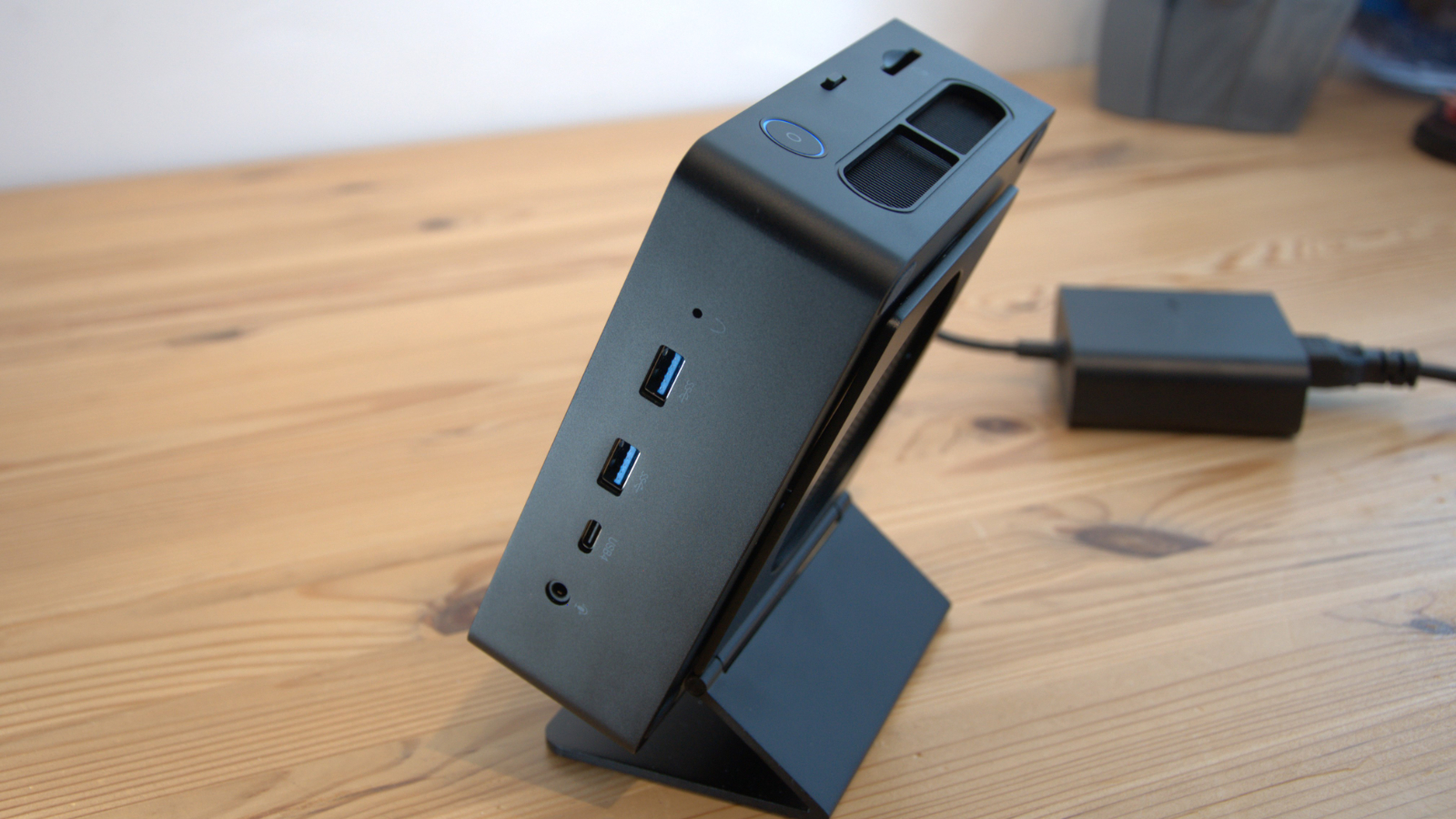
AtomMan X7 Ti: Verdict
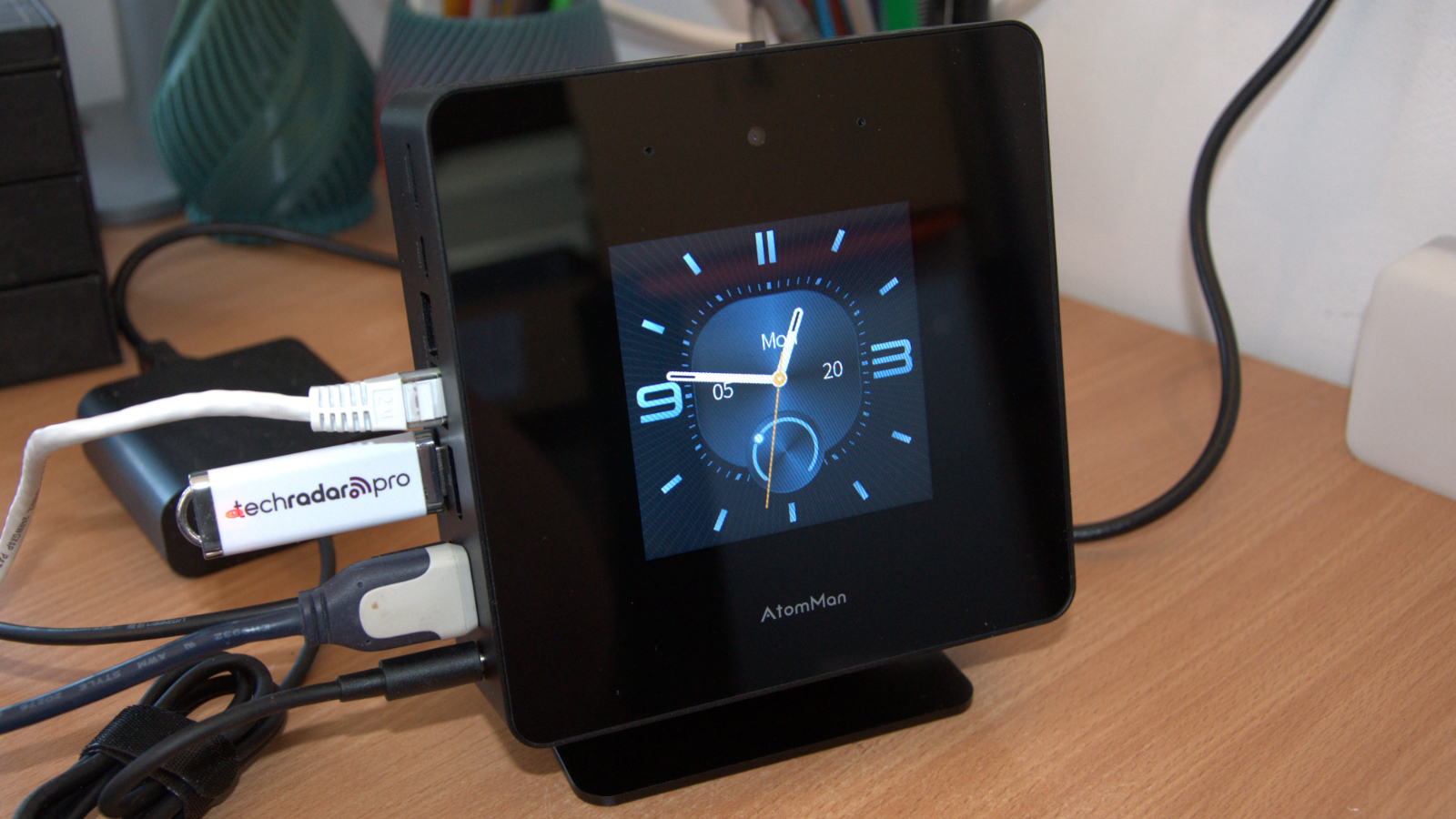
With so many system makers producing the same plastic enclosures for these devices, it is great to see Minisforum take the high ground with quality construction that does the internal specifications justice.
Beyond the spectacular new platform, there are some interesting innovations, the best of which is the OCulink technology. Some other special features, such as the touch display, seem less endearing.
However, it needs to be noted that this machine doesn’t deliver much greater performance than the much cheaper AMD Ryzen 7 options. Also, the designers left Thunderbolt out of this equation for some reason.
The information display is currently a gimmick, and it badly needs an application so you can change the clock designs or the language without knowing what the menu options are in Chinese. Until it can tell you that you have an unread email waiting, then this feature is still looking for a killer purpose.
We’d be interested to see how well this system runs with the eGPU add-on, as it might become a relatively inexpensive workstation when used with a high-end GPU.
Connecting an external GPU option is also a feature of the upcoming Thunderbolt 5.0, should system makers put it in their machines.
Should I buy a AtomMan X7 Ti?
| Value | Not cheap, but excellent engineering | 4/5 |
| Design | Unlike anything else we’ve seen. Some of this design is great, and other aspects, like internal access, are poor. | 4/5 |
| Features | Dual M.2 Gen 4 slots, no Thunderbolt but dual USB 4.0, quad monitor support and dual 5GbE LAN ports. | 4/5 |
| Performance | The current king of the hill for mini-systems, but AMD isn’t far behind. | 4.5/5 |
| Overalls | Highly engineered and uniquely featured, this is the perfect choice for those who want lots of power in a small package. | 4.5/5 |
Buy it if...
You want extra performance
This mini-system is remarkably powerful and can handle applications that use multi-threading to improve processing times. This processor also has AI capabilities if you use local applications that can harness that power.
You want extra GPU power
While the Intel ARC is probably the best integrated GPU, the inclusion of an OCulink port provides an option to use an external GPU for even more power.
Don't buy it if...
You insist on value for money
As nice as the X7 Ti is, the asking price is inflated due to the processor and other technologies included in it. Those who want a powerful NUC can find them much cheaper than this one on both AMD and Intel platforms.
You need Thunderbolt
While it has both USB 4.0 and OCulink, it doesn’t have Thunderbolt. And, due to the nature of that technology, it isn’t possible to add it on.
Also consider
Acemagic F2A
Using the latest Ultra 5 class processor from Intel with the ARC-integrated GPU. This is another powerhouse solution, but it is from a different stable.
The downsides to this option are that this isn't especially cheap and it doesn't have USB 4.0 or Thunderbolt. But it's another powerful small system to consider.
Check out our Acemagic F2A hands on
GMKtec NucBox K8
Built using the latest 8000 series chips from AMD. In most comparisons, the K8 performs close to the X7 Ti, but it also has AI processing if you need that functionality.
Check out our GMKtec NucBox K8 review
Mark is an expert on 3D printers, drones and phones. He also covers storage, including SSDs, NAS drives and portable hard drives. He started writing in 1986 and has contributed to MicroMart, PC Format, 3D World, among others.

